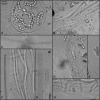Cyanobacterial diversity in natural and artificial microbial mats of Lake Fryxell (McMurdo Dry Valleys, Antarctica): a morphological and molecular approach
- PMID: 12957897
- PMCID: PMC194958
- DOI: 10.1128/AEM.69.9.5157-5169.2003
Cyanobacterial diversity in natural and artificial microbial mats of Lake Fryxell (McMurdo Dry Valleys, Antarctica): a morphological and molecular approach
Abstract
Currently, there is no consensus concerning the geographic distribution and extent of endemism in Antarctic cyanobacteria. In this paper we describe the phenotypic and genotypic diversity of cyanobacteria in a field microbial mat sample from Lake Fryxell and in an artificial cold-adapted sample cultured in a benthic gradient chamber (BGC) by using an inoculum from the same mat. Light microscopy and molecular tools, including 16S rRNA gene clone libraries, denaturing gradient gel electrophoresis, and sequencing, were used. For the first time in the study of cyanobacterial diversity of environmental samples, internal transcribed spacer (ITS) sequences were retrieved and analyzed to complement the information obtained from the 16S rRNA gene. Microscopy allowed eight morphotypes to be identified, only one of which is likely to be an Antarctic endemic morphotype. Molecular analysis, however, revealed an entirely different pattern. A much higher number of phylotypes (15 phylotypes) was found, but no sequences from Nodularia and Hydrocoryne, as observed by microscopy, were retrieved. The 16S rRNA gene sequences determined in this study were distributed in 11 phylogenetic lineages, 3 of which were exclusively Antarctic and 2 of which were novel. Collectively, these Antarctic sequences together with all the other polar sequences were distributed in 22 lineages, 9 of which were exclusively Antarctic, including the 2 novel lineages observed in this study. The cultured BGC mat had lower diversity than the field mat. However, the two samples shared three morphotypes and three phylotypes. Moreover, the BGC mat allowed enrichment of one additional phylotype. ITS sequence analysis revealed a complex signal that was difficult to interpret. Finally, this study provided evidence of molecular diversity of cyanobacteria in Antarctica that is much greater than the diversity currently known based on traditional microscopic analysis. Furthermore, Antarctic endemic species were more abundant than was estimated on the basis of morphological features. Decisive arguments concerning the global geographic distribution of cyanobacteria should therefore incorporate data obtained with the molecular tools described here.
Figures


Similar articles
-
Biogeographical distribution and ecological ranges of benthic cyanobacteria in East Antarctic lakes.FEMS Microbiol Ecol. 2006 Aug;57(2):272-89. doi: 10.1111/j.1574-6941.2006.00110.x. FEMS Microbiol Ecol. 2006. PMID: 16867145
-
Diversity within cyanobacterial mat communities in variable salinity meltwater ponds of McMurdo Ice Shelf, Antarctica.Environ Microbiol. 2005 Apr;7(4):519-29. doi: 10.1111/j.1462-2920.2005.00717.x. Environ Microbiol. 2005. PMID: 15816929
-
16S rDNA diversity of cultured and uncultured prokaryotes of a mat sample from Lake Fryxell, McMurdo Dry Valleys, Antarctica.Extremophiles. 2001 Feb;5(1):23-33. doi: 10.1007/s007920000169. Extremophiles. 2001. PMID: 11302499
-
Low cyanobacterial diversity in biotopes of the Transantarctic Mountains and Shackleton Range (80-82°S), Antarctica.FEMS Microbiol Ecol. 2011 Sep;77(3):503-17. doi: 10.1111/j.1574-6941.2011.01132.x. Epub 2011 Jul 4. FEMS Microbiol Ecol. 2011. PMID: 21592144
-
A natural view of microbial biodiversity within hot spring cyanobacterial mat communities.Microbiol Mol Biol Rev. 1998 Dec;62(4):1353-70. doi: 10.1128/MMBR.62.4.1353-1370.1998. Microbiol Mol Biol Rev. 1998. PMID: 9841675 Free PMC article. Review.
Cited by
-
ToRQuEMaDA: tool for retrieving queried Eubacteria, metadata and dereplicating assemblies.PeerJ. 2021 May 5;9:e11348. doi: 10.7717/peerj.11348. eCollection 2021. PeerJ. 2021. PMID: 33996287 Free PMC article.
-
Biodiversity of methanogenic and other archaea in the permanently frozen Lake Fryxell, Antarctica.Appl Environ Microbiol. 2006 Feb;72(2):1663-6. doi: 10.1128/AEM.72.2.1663-1666.2006. Appl Environ Microbiol. 2006. PMID: 16461723 Free PMC article.
-
New cyanobacterial genus Argonema is hidding in soil crusts around the world.Sci Rep. 2022 May 3;12(1):7203. doi: 10.1038/s41598-022-11288-4. Sci Rep. 2022. PMID: 35504986 Free PMC article.
-
Alternative Biosynthetic Starter Units Enhance the Structural Diversity of Cyanobacterial Lipopeptides.Appl Environ Microbiol. 2019 Feb 6;85(4):e02675-18. doi: 10.1128/AEM.02675-18. Print 2019 Feb 15. Appl Environ Microbiol. 2019. PMID: 30504214 Free PMC article.
-
Culturable diversity of heterotrophic bacteria in Forlidas Pond (Pensacola Mountains) and Lundström Lake (Shackleton Range), Antarctica.Microb Ecol. 2011 Aug;62(2):399-413. doi: 10.1007/s00248-011-9842-7. Epub 2011 Mar 22. Microb Ecol. 2011. PMID: 21424822
References
-
- Anagnostidis, K., and J. Komárek. 1988. Modern approach to the classification system of cyanophytes. 3. Oscillatoriales. Arch. Hydrobiol. 50/53(Suppl. 80):327-472.
-
- Baurain, D., L. Renquin, S. Grubisic, and P. Scheldeman. 2002. Remarkable conservation of internally transcribed spacer sequences of Arthrospira (“Spirulina”) (Cyanophyceae, Cyanobacteria) strains from four continents and of recent and 30-year-old dried samples from Africa. J. Phycol. 38:384-393.
-
- Benlloch, S., S. G. Acinas, J. Anton, L. Lopez, S. P. Luz, and F. Rodiguez-Valera. 2001. Archeal biodiversity in crystallizer ponds from a solar saltern: culture versus PCR. Microb. Ecol. 41:12-19. - PubMed
Publication types
MeSH terms
Substances
LinkOut - more resources
Full Text Sources
Molecular Biology Databases

